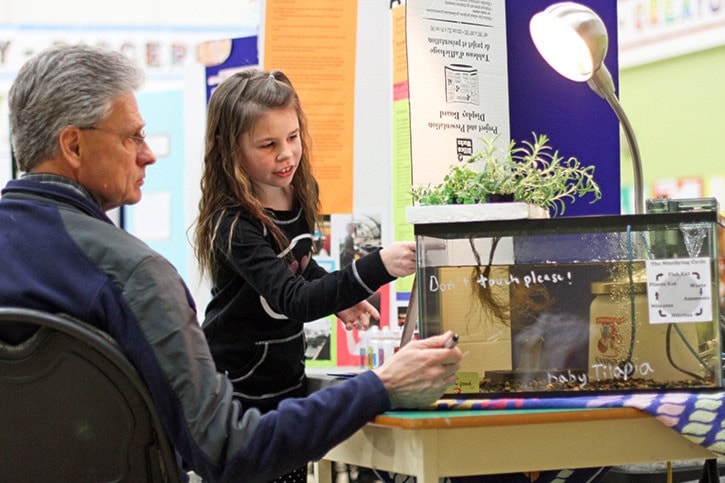For someone who’s only in Grade 4, Gracie knows a lot about aquaponics.
She speaks quickly about the nitrogen cycle between excited breaths, working through subjects like the tilapia she includes in her system and even the early cultures of the world that used the idea long ago.
“I learned that it's very hard to keep the nitrogen cycle going,” Gracie says. “And about good bacteria, bad bacteria.”
Standing between her fish tank (with plant perched on top) and her science fair judge Wayne Richards, the young Agassiz Christian school student politely asks if she should speak slower for Richards.
The two were among a gym full of children describing their displays to judges Tuesday during the school’s science fair.
Alternating every second year with a heritage fair, the event hosted 17 external judges this year including a geologist, a vice-principal, a University of the Fraser Valley professor, community members and many former educators.
“It gives kids variety, it gives kids an opportunity to really pursue something in depth,” says John Zuidhof, Agassiz Christian’s principal. “And to display their learning, because too often too much of the learning just stays in the classroom.”
On the other side of the gym floor, Mark Gross listens to Grade 6 student Camryn’s presentation about homemade bath bombs.
Gross is retired from working in the Pacific Agri-Food Research Centre and is interested in many sciences. This is his third time helping with the fair.
“This is truly experimental,” he says nodding to the presentation in front of his seat, clipboard in hand. “It's a fun thing to do and it's really good to support the kids and give them a chance to demonstrate their knowledge and have an audience, and it's good for their development.”
Grades 4 to 7 have an opportunity to talk to two different judges like Gross, and kindergarten to Grade 3 students have an interview from one volunteer.
The lower grades’ projects line the walls surrounding their seniors’ displays and are more theme specific, giving them a guided introduction to the concept, but including students right from the start of their academic careers.
Grade 6 and 7 teacher Dan Verbeek says the big takeaway for most students is the ownership they have over their project subject matter and how that drives their learning.
“It's all them, so they get to take pride in this,” he says scanning the hard work on display. “These posters show they thoroughly enjoyed them.”
Verbeek says the buy-in from students results in a multi-faceted project that the creator is immersed in, often resulting in education they’re not even aware they are receiving.
“They do take a lot of work, but in the end we get these amazing projects,” he says. “And they show that most of the students really grab the full concept of what they've been studying—that they are really understanding it.”
After a holiday trip to You Grow Food, an aquaponics business in Hope, Gracie was interested enough in the concept to dedicate her science project to the practice.
And she might even go a step further if she sticks with her claims about this experiment on Tuesday.
“It inspired me to make a company of my own,” she says. “I will grow plants and I'll grow fish [in the future].”

